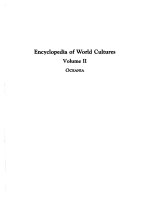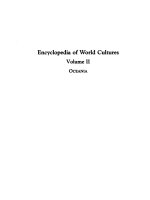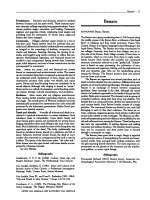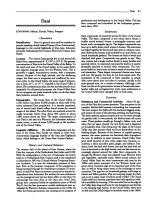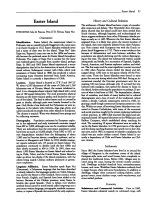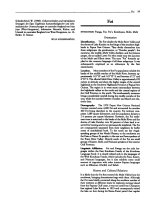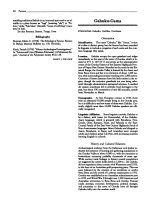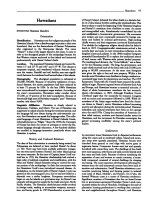Encyclopedia of World Cultures Volume III - South Asia - I ppt
Bạn đang xem bản rút gọn của tài liệu. Xem và tải ngay bản đầy đủ của tài liệu tại đây (767.72 KB, 6 trang )
Indian
Christian
103
Bibliography
Chaudhuri,
Nirad
C.
(1979).
Hinduism,
a
Religion
to
Live
By.
New
York:
Oxford
University
Press;
London:
Chatto
&
Windus.
Zaehner,
R
C.
(1962).
Hinduism.
London:
Oxford
Univer-
sity
Press.
PAUL
HOCKINGS
Stutley,
Margaret,
and
James
Stutley
(1977).
Harper's
Dic-
tionary
of
Hinduism:
Its
Mythology,
Folklore,
Philosophy,
Liter-
ature,
and
History.
New
York:
Harper
&
Row.
Indian
Christian
ETHNONYMS:
none
Indian
Christians
are
believers
in
the
divinity
of
Jesus
Christ.
Despite
the
persisting
idea
in
South
Asia
that
Chris-
tianity
is
the
"white
man's
religion,"
it
has
a
massive
following
today
in
the
subcontinent.
Still,
it
is
very
much
a
minority
faith,
accounting
for
nearly
8
percent
of
the
Sri
Lankan
popu-
lation
but
less
than
3
percent
in
each
of
the
other
South
Asian
countries.
In
1991
India
had
an
estimated
21
million
Christians,
and
the
other
South
Asian
countries
together
had
another
3
million.
The
idea
that
Christianity
was
introduced
by
the
colo-
nial
powers-Roman
Catholicism
by
the
Portuguese
and
then
Anglicanism
by
the
English-is
not
strictly
true.
Kerala
and
some
other
parts
of
the
west
coast
had
certainly
been
evangelized
by
Nestorian
missionaries
since
the
sixth
century,
and
many
in
south
India
believe
that
the
apostle
Thomas
came
to
Tamil
Nadu
and
was
martyred
and
buried
in
what
is
now
Madras
city.
These
early
religious
connections
were
with
Syria
(cf.
Syrian
Christians).
The
Portuguese
brought
Portu-
guese
and
Italian
priests
with
them,
and
in
1557
Goa,
their
major
Indian
colony,
became
an
archbishopric.
With
the
founding
of
the
East
India
Company
in
1600
the
English
in-
troduced
the
Anglican
faith,
and
as
time
passed
other
Protes-
tant
sects
appeared.
The
years
1850-1900
were
the
high
point
of
Protestant
mission
activity
in
South
Asia,
with
min-
isters
from
America
and
virtually
every
country
in
Europe
vying
for
converts,
especially
among
the
Untouchables,
tri-
bals,
and
downtrodden
slum
dwellers.
In
some
areas
they
were
dramatically
successful
at
gaining
converts:
the
Mizos
of
northeastern
India
are
nearly
all
Christians
today,
thanks
to
the
somewhat
obscure
Welsh
Baptist
mission.
At
the
other
end
of
the
country,
though,
the
Badagas
are
97
percent
Hindu
after
seventy
years
of
concerted
effort
by
the
Basel
Evangelical
mission,
followed
by
another
seventy
years
of
other
missionary
activity.
The
Roman
Catholic
missionaries
have
not
fared
any
better
among
the
Badagas;
but
elsewhere
there
are
large
Catholic
congregations
in
many
towns
and
cit-
ies.
By
the
Congregation
de
Propaganda
Fide
(1622)
the
Catholic
church
encouraged
the
training
of Indian
priests,
and
also
brought
in
large
numbers
of
European
Jesuits
in
a
su-
pervisory
capacity.
The
year
1947
marked
a
landmark
in
Protestant
church
history,
not
just
because
this
was
the
year
of
independence
for
both
India
and
Pakistan
but
also
because
it
was
the
year
when
the
Church
of
South
India
came
into
being-the
first
unified
Protestant
church
anywhere.
It
of
course
absorbed
the
former
Anglican,
Methodist,
and
several
other
sectarian
institutions.
In
1970
there
followed
a
unified
Protestant
Church
of
North
India
and
a
Protestant
Church
of
Pakistan.
These
churches,
both
Protestant
and
Catholic,
are
now
entirely
in
the
hands
of
South
Asian
bishops
and
archbish-
ops,
with
very
few
of
the
former
European
missionaries
re-
maining.
In
Sri
Lanka
and
south
India,
the
greatest
growths
have
recently
been
seen
among
the
Roman
Catholics,
not
primarily
because
of
new
conversions
but
rather
because
of
a
calculated
avoidance
of
family
planning.
In
Nepal
Christian
and
Muslim
missionary
activity
is
prohibited
by
law.
The
history
of
Christianity
in
South
Asia
has
indeed
been
a
checkered
one,
but
it
has
been
an
important
instru-
ment
of
Westernization.
The
first
printing
presses
and
the
first
modem
colleges
were
introduced
by
European
missionar-
ies.
By
the
middle
of
the
nineteenth
century
these
people
were
making
important
contributions
to
the
general
social
uplift
of
the
country
(and
not
only
for
Christian
converts)
by
their
promotion
of
rural
and
urban
schooling,
adult
literacy,
female
education,
colleges,
hospitals
and
clinics,
and
modem
urban
careers.
As
a
result
the
Christian
population
has
wielded
a
disproportionate
influence
in
modem
Indian
and
Sri
Lankan
life.
Little
conversion
is
still
taking
place.
Indian
Christians
today
tend
to
be
urban,
are
always
mo-
nogamous,
and
form
nuclear
families
upon
marriage
(which
takes
place
in
a
church).
They
usually
follow
Westernized
professions,
becoming
teachers,
nurses,
bank
clerks,
and
civil
servants.
See
also
Europeans
in
South
Asia;
Syrian
Christian
of
Kerala
Bibliography
Coutinho,
Fortunato
(1958).
Le
regime
paroissial
des
dioceses
de
rite
latin
de
l'Inde
des
origines
(XVIe
siecle
a
nos
jours).
Paris:
Editions
Biatrice-Nauwelaerts.
Gibbs,
Mildred
E.
(1972).
The
Anglican
Church
in
India,
1600-1970.
Delhi:
Indian
Society
for
Promoting
Christian
Knowledge.
Nanjundayya,
H.
V.,
and
L.
K.
Ananthakrishna
Iyer
(1930).
"Indian
Christian."
In
The
Mysore
Tribes
and
Castes,
edited
by
H.
V.
Nanjundayya
and
L.
K.
Ananthakrishna
Iyer.
Vol.
3,
1-76.
Mysore:
Mysore
University.
Neill,
Stephen
(1984).
A
History
of
Christianity
in
India.
2
vols.
Cambridge:
Cambridge
University
Press.
Thomas,
Abraham
V.
(1974).
Christians
in
Secular
India.
Rutherford:
Fairleigh
Dickinson
University.
PAUL
HOCKINGS
104
Irula
Irula
ETHNONYMS:
Erilagaru,
Iraligar,
Irulan,
Kasaba,
Kasava,
Kasuba,
Ten
Vanniya,
Vana
Palli,
Villaya
Orientation
Identification.
Most
Irula
inhabit
the
state
of
Tamil
Nadu,
India.
Although
they
form
a
Scheduled
Tribe,
the
Irula
are
in
many
ways
similar
to
their
nearby
Hindu
caste
neigh-
bors.
They
have
pantheistic
and
animistic
tendencies
of
their
own,
but
prolonged
contact
with
more
orthodox
Hinduism
has
also
had
its
indelible
impact.
Location.
Most
Irula
live
in
the
northern
districts
of
Tamil
Nadu,
where
the
majority
are
found
in
the
Changalpattu,
North
Arcot,
and
South
Arcot
districts
not
far
from
Madras
City.
While
the
Irula
in
general
merit
additional
fieldwork,
it
is
only
the
Nilgiri
Irula
who
are
considered
here.
They
live
in
the
Nilgiri
District
in
extreme
northwestern
Tamil
Nadu,
in
the
adjacent
Coimbatore
District,
and
in
parts
of
Karnataka
and
Kerala
states.
Tamil
Nadu
is
the
southeasternmost
state
of
India.
It
is
thus
a
region
within the
tropics
that
is
subject
to
westerly
monsoonal
rainfall,
lasting
mainly
from
mid-June
through
August,
and
to
reverse
monsoonal
rainfall,
which
is
heaviest
from
September
into
November.
Some
Nilgiri
Irula
occupy
higher
and
cooler
slopes,
and
others
occupy
plains
that
by
April
are
hot
and
dry.
Demography.
After
the
Malayali
(who
actually
are
not
the
speakers
of
Malayalam
in
Kerala)
numbered
at
159,426,
the
Irula
at
89,025
formed
the
second-largest
Tamil
Nadu
tribe
in
the
1971
census
of
India.
There
were
over
12,000
Irula
in
the
Coimbatore
District.
As
the
Nilgiri
District
had
some
5,200
Irula
in
1971,
only
about
6
percent
lived
there.
By
1971,
there
were
altogether
106,939
Irula
in
south
India.
Unguistic
Affiliation.
Depending
on
the
criteria
used,
the
Irula
have
been
identified
as
speakers
of
a
distinct
Irula
lan-
guage
or
speakers
of
a
dialect
of
Tamil.
In
addition,
Mala-
yalam
has
influenced
Irula
speech
in
Kerala,
and
Kannada
has
influenced
the
speech
of
a
subgroup
of
Irula,
called
Kasaba,
in
Karnataka.
History
and
Cultural
Relations
Many
of
the
lowland
Nilgiri
Irula
live
near
impressive
mega-
lithic
sites,
so
the
question
of
whether
they
could
possibly
be
descendants
of
inhabitants
living
in
ancient
times
naturally
arises.
Particularly
among
the
hoe-using
Irula
of
the
Nilgiri
slopes,
there
are
farming
practices
that
may
represent
neo-
lithic
survivals.
Our
earliest
description
of
the
Nilgiri
Irula
in
English,
by
Francis
Buchanan
who
visited
them
in
1800,
briefly
provides
an
overview
of
how
the
Irula
then
survived.
The
descendants
of
these
Irula
ultimately
were
to
be
affected
profoundly
by
the
spread
of
plantation
agriculture
(mainly
tea
and
coffee)
by
the
British.
Many
lowland
Irula,
having
more
frequent
contacts
with
urban
centers,
probably
have
long
been
a
part
of
the
lowland
cultural
continuum
and
changing
civilization.
The
Irula
are
best
understood
as
being
primarily
either
lowlanders
with
many
lowland
ties
or
up-
landers
with
both
upland
and
lowland
ties.
The
lowlanders,
users
of
the
plow
and
even
cultivators
of
wet
rice,
often
live
with
the
members
of
other
castes
involved
in
similar
agricul-
tural
pursuits.
Because
the
upland
Irula
formerly
lived
on
the
forested
outer
slopes
of
the
Nilgiris,
they
did
not
develop
ties
as
close
as
those
that
existed
between
the
upland
Badaga,
Kota,
and
Toda.
However,
they
often
lived
with
or
close
to
the
Kurumba
(powerful
magicians
and
doctors,
in
both
the
Alu
and
Palu
groups),
and
they
still
do.
After
plantations
spread
over
formerly
forested
outer
slopes,
most
of
the
upland
Irula
became
plantation
laborers
with
ties
to
a
plantation
in-
frastructure.
Many
uplanders
thus
came
to
lead
a
dual
exis-
tence:
plantation
laborers
by
day
and
Irula
hamlet
dwellers
by
night.
Today,
an
efficient
bus
service
enables
lowlanders
to
travel
more
easily
to
lowland
urban
centers.
While
some
up-
landers
may
occasionally
walk
the
long
distances
down
and
up
that
are
necessary
to
visit
lowland
urban
centers,
it
is
gen-
erally
far
easier
for
an
uplander
to
travel
to
a
nearby
upland
urban
center.
Yet
kinship
and
ritual
ties
still
keep
the
upland
and
lowland
Irula
in
close
contact
with
each
other.
Settlements
The
Irula
tend
to
place
their
houses
together
in
hamlets
or
villages
called
mottas.
After
the
British
moved
to
end
shifting
(kottukadu
or
kumri)
agriculture,
starting
at
the
time
of
the
land
settlements
in
the
1880s,
it
became
increasingly
difficult
for
the
Irula
to
farm
in
this
way.
However,
to
the
limited
de-
gree
that
some
still
manage
to
follow
this
practice
in
the
wild-
est
areas,
there
may
be
as
a
result
scattered
single
houses
next
to
temporary
plots.
Kasaba
who
live
in
a
wildlife
sanctuary
are
also
likely
to
reside
in
separate
houses.
In
hamlets,
often
with
less
than
fifty
people,
there
are
separate
houses,
houses
aligned
into
rows,
or
a
combination
of
the
two
patterns.
The
alignment
of
houses
was
traditional,
but
the
practice
was
re-
inforced
when
plantation
managers
had
"coolie
lines,"
houses
built
in
rows
for
their
laborers.
Houses
provided
by
the
government
also
tend
to
be
aligned.
A
courtyard
fronting
a
house
is
the
most
common
adjunct,
and
houses
within
a
hamlet
are
invariably
next
to
one
or
more
courtyards.
Some
traditional
Irula
hamlets
of
the
outer
Nilgiri
slopes
might
still
have
separate
'pollution
huts"
or
special
rooms
for
women
delivering
infants,
for
women
in
the
postpartum
stage,
or
for
women
who
are
menstruating.
In
the
traditional
way,
too,
there
is
a
tendency
toward
a
proliferation
of
small
huts
to
serve
separate
functions,
and
these
huts
are
constructed
next
to
courtyards.
Apart
from
the
common
firewood
storage
huts
and
chicken,
goat,
or
sheep
huts,
there
may
also
be
a
separate
hut
just
for
drums.
In
these
hamlets
there
is
typically
an
ab-
sence
of
temples.
In
each
of
the
main
villages
of
Hallimoyar,
Kallampalayam,
and
Thengumarahada,
located
on
the
low.
land
northeast
of
the
Nilgiri
massif
and
close
to
the
Moyar
River,
there
are
over
100
Irula.
Because
caste
people
(of
which
the
Badaga
and
Okkaliga
are
prominent)
live
with
the
Irula
and
because
each
of
these settlements
has
considerable
governmental
investment,
the
Irula
tend
to
be
like
their
neighbors.
Pollution
huts
or
rooms
and
special
purpose
huts
are
thus
usually
absent,
and
temples
are
present.
Because
all
the
Irula
still
have
a
drive
toward
gardening,
garden
plants
are
usually
planted
in
and
adjacent
to
Irula
settlements.
Even
a
separate
house
next
to
a
temporary
millet
field
is
thus
likely
to
have
some
garden
plants
growing
nearby.
Jackfruit
and
mango
trees
typically
gain
a
firm
foothold
in
and
close
to
per-
manent
settlements,
and
the
drought-resistant
neem
(Mar-
Irula
105
gosa)
and
tamarind
are
often
present
within
lowland
settle-
ments.
The
lowland
Irula
who
herd
cattle
for
others,
typically
in
drier
areas
with
thorn
forest,
are
associated
with
a
distinc-
tive
settlement
pattern
in
which
a
large
cattle
enclosure
is
sur-
rounded
by
a
thorny
wall
of
piled
branches.
The
Irula
also
have
burial
grounds
with
ancestral
temples,
called
koppa
manais,
in
which
stones
associated
with
the
departed
spirits
of
the
dead
are
housed.
Each
patrician
has
a
burial
place
and
a
koppa
manai,
but
the
two
are
not
necessarily
together
(for
example,
while
Samban
people
are
only
buried
at
Kallampa-
layam,
there
are
Samban
koppa
manais
at
Hallimoyar
and
Kunjappanai).
Although
a
burial
ground
is
usually
close
to
a
settlement,
it
can
be
farther
away.
As
in
many
other
parts
of
Asia
and
into
the
Pacific
Basin,
the
sacredness
of
a
burial
ground
is
often
associated
with
the
pagoda
tree
(the
Polyne-
sian
frangipani).
Largely
because
many
of
the
Irula
are
landless
laborers,
most
of
them
live
in
one-roomed
houses.
Nevertheless,
Irula
plantation
laborers
inhabiting
the
Nilgiri
slopes
still
occupy
bipartite
houses
with
the
sacred
cooking
area
formally
separated
(typically
not
with
a
wall
but
with
a
shallow
earthen
platform)
from
the
living
and
sleeping
areas.
The
Kasaba
to
the
north
of
the
Nilgiri
massif,
who
herd
cattle
for
others
(Badagas
included),
occupy
tripartite
structures
with
living
quarters
for
humans
to
one
side
of
a
room
with
an
open
front,
and
a
calf
room
to
the
other
side.
The
open
front
of
the
center
room
facilitates
the
watching
of
the
enclosed
cattle
at
night,
and
it
is
most
useful
when
predators
or
wild
el-
ephants
come
near.
While
traditional
Irula
houses
are
made
of
wattle
and
daub,
with
thatched
roofs
(or
in
some
instances
banana
sheaths
for
walling
and
roofing),
more
Irula
are
living
in
houses
with
walls
of
stone
or
brick
and
roofs
with
tiles,
es-
pecially
if
the
government
has
provided
financial
assistance.
Economy
Subsistence
and
Commercial
Activities.
The
earliest
re-
ports
indicate
that
the
hoe-using
Irula
of
the
eastern
Nilgiri
slopes
obtained
one
crop
of
millet
in
a
year
from
shifted
plots,
involving
a
growing
period
that
coincided
with
the
westerly
monsoon.
They
then
depended
upon
garden
produce,
gath-
ered
edibles,
and
hunting
for
survival
once
the
harvested
grain
had
been
consumed.
That
these
Irula
were
probably
named
after
a
yam
species
is
indicative
of
how
important
yams
were
to
them
when
they
turned
to
gathering.
Several
wild
yam
species
were
available.
Irula
are
still
well
known
for
the
gathering
and
supply
of
honey
to
their
neighbors.
Despite
sculptured
representations
of
bows
and
arrows
in
some
Nilgiri
dolmens
at
higher
elevation,
it
is
noteworthy
that
the
Irula
seem
always
to
have
used
nets
and
spears
when
they
hunted.
Our
record
of
at
least
eighty
species
of
plants
growing
in
Irula
gardens
testifies
to
the
past
and
continuing
significance
of
gardens
to
all
the
Irula.
That
at
least
twenty-five
of
the
identi-
fied
plants
had
a
New
World
origin
also
proves
the
willing-
ness
of
the
Irula
to
incorporate
introduced
species
into
their
economy.
The
continued
cultivation
of
finger
millet
(Eleusine
corocana),
Italian
millet
(Setaria
italica),
and
little
millet
(Panicum
sumatrense)
and
no
dry
rice
by
the
Irula
on
the
higher
slopes
may
in
itself
represent
a
Neolithic
survival,
be-
cause
the
cultivation
of
dry
rice
has
in
Southeast
Asia
widely
replaced
the
earlier
cultivation
of
the
Italian
and
little
millets
from
China.
The
Irula
still
commonly
grow
these
two
species
of
millet
together
and
then
harvest
the
Italian
millet
when
the
little
millet
is
far
from
maturation.
Very
small
sickles
are
used
for
harvesting
individual
grain
heads.
When
finger
millet
(grown
apart
from
the
other
two)
is
to
be
harvested,
the
plants
are
visited
periodically
to
permit
the
removal
of
grain
as
it
ripens.
Another
economic
pursuit
that
may
have
contin-
ued
from
Neolithic
times,
during
which
cattle
rearing
was
widespread
in
southern
India,
is
the
manner
by
which
low-
land
Irula
in
forested
areas
keep
cattle
for
their
neighbors
(Kuruvas
included).
The
few
Irula
who
still
manage
to
prac-
tice
shifting
agriculture
set
fire
in
April
or
May
to
the
vegeta-
tion
they
have
cut,
so
the
cultivation
of
millet
will
then
take
place
during
the
westerly
monsoon.
The
barnyard
millet
(Echinochloa),
bullrush
millet
(Pennisetum),
common
millet
(Panicum
miliaceum)
and
sorghum
millet
(Sorghum),
all
of
the
lowland,
renowned
for
their
drought
resistance,
and
thus
typically
grown
on
dry
fields,
are
cultivated
with
the
aid
of
plows
and
mainly
in
the
season
of
the
westerly
monsoon.
Now
with
the
cooperation
of
the
Forest
Department,
the
Irula
gather
forest
produce
(including
medicinal
plants)
for
sale.
Since
most
Irula
of
the
Nilgiri
slopes
currently
work
as
plantation
laborers,
plantation
managements
starting
with
those
in
the
time
of
the
British
Raj
had
to
provide
periodic
re-
lease
time
for
those
Irula
who
needed
to
perform
their
own
agricultural
chores.
The
Gandhian
quest
to
improve
the
lives
of
members
of
the
Scheduled
Tribes
is
demonstrated
by
the
manner
in
which
the
government
has
enabled
Irula
of
the
eastern
Nilgiri
slopes
to
establish
coffee
and
tea
gardens
of
their
own,
and
at
Kunjappanai
the
Silk
Board
of
the
govern-
ment
of
Tamil
Nadu
is
now
providing
financial
assistance
to
enable
silkworm
farming
among
the
Irula.
From
1974
the
government
gave
small
plots
to
Irula
on
the
eastern
slopes,
and
the
Cooperative
Land
Development
Bank
(an
agency
of
the
Tamil
Nadu
government)
at
the
nearest
town
(Kotagiri)
was
by
1979
helping
to
finance
the
growing
of
coffee
and
tea
in
nurseries,
so
that
the
Irula
could
have
their
own
commer-
cialized
gardens.
While
a
few
Irula
who
wisely
managed
their
granted
lands
and
loans
prospered,
many
did
not
manage
their
endeavors
well
and
the
return
payment
on
loans
at
a
low
rate
was
eventually
ended
in
many
instances
by
a
special
bill
passed
in
Madras
by
the
Tamil
Nadu
government.
It
is
pri-
marily
the
cooperation
of
the
government,
with
the
Forest
Department
of
Tamil
Nadu
playing
an
important
role,
that
has
enabled
more
lowland
Irula
to
become
involved
in
the
an-
nual
cultivation
of
irrigated
rice.
Hallimoyar,
Kallampalayam,
and
Thengumarahada
(with
its
Cooperative
Society),
in
which
the
Irula
live
close
to
the
members
of
several
castes,
have
irrigation
networks.
One
rice
crop
started
in
March
is
harvested
in
June,
and
the
second
crop
started
in
July
is
ready
in
December.
In
1978
a
newly
constructed
rice
mill
became
operational
at
Thengumarahada.
Irula
living
to
the
south
of
the
Nilgiri
massif
are also
involved
in
wet
rice
cultivation.
There,
apart
from
irrigation
water
from
surface
flow
(Coo-
noor
River
is
the
most
important),
subsurface
water
is
now
being
obtained
with
electric
pumps.
The
main
rice
crop
is
grown
from
June
into
January
or
February,
and
the
growing
of
short-maturation
rice
enables
the
production
of
a
second
crop
from
February
to
May.
As
lowland
population
increases,
the
majority
of
the
lowland
Irula
(who
own
no
land)
are
in-
creasingly
beset
by
the
problem
of
obtaining
work
wherever
possible.
Some
are
employed
in
the
irrigated
areca
groves
near
Mettupalaiyam,
reputed
to
form
the
largest
human-made
106
forest
of
its
kind
in
the
world.
Post-World
War
II
dam
proj-
ects,
including
that
of
Bhavani
Sagar,
created
temporary
work
for
others.
Many
Irula
have
entered
the
general
job
market
in
the
Coimbatore-Mettupalaiyam-Ootacamund
region
and
are
employed
in
a
wide
array
of
jobs
in
the
public
and
private
sec-
tors.
Such
jobs
include
positions
in
air
force
and
army
camps,
nationalized
banks,
the
income
tax
office,
the
Post
and
Tele-
graph
Department,
the
Railway
Department,
the
Sugarcane
Breeding
Institute
and
Pankaja
Mill,
both
in
Coimbatore
(the
only
mill
that
employs
Irulas,
out
of
twenty
surveyed),
the
cordite
factory
at
Aruvankadu,
and
the
Hindustan
Photo-
Film
industry
near
Ootacamund.
The
Irula
have
cattle,
chick-
ens,
dogs,
goats,
and
sheep,
and
a
few
of
them
may
keep
buf-
falo,
pigeons,
or
pigs.
Pigs,
dogs,
and
chickens
serve
as
scavengers
in
some
lowland
hamlets.
Jungle
fowl,
Nilgiri
lan-
gurs,
parrots,
peacocks,
quail,
and
assorted
squirrels
appear
to
be
the
most
commonly
tamed
wild
creatures.
Industrial
Arts.
The
Irula
make
their
own
drums
and
wind
instruments
for
their
musical
enjoyment.
The
Kota
of
the
upper
Nilgiris
generally
no
longer
supply
music
as
they
once
traditionally
did,
so
the
Irula
are
now
frequently
employed
as
musicians
at
Badaga
and
Toda
funerals.
Trade.
A
kind
of
bartering
trade
has
persisted
for
genera-
tions
between
the
Kina-r.
Kota
of
the
upper
Nilgiris
and
the
nearby
Irula.
The
Kota
obtain
honey,
brooms,
winnowers
and
baskets
made
of
bamboo
and
banana
sheath
strips,
punk
used
to
light
fires
(Kota
priests
may
not
use
matches
to
light
fires)
and
resin
incense
from
the
Irula
in
return
for
iron
field
and
garden
implements
made
by
Kota
blacksmiths.
Division
of
Labor.
Women
still
perform
all
the
house-
hold-related
tasks.
While
males
perform
those
agricultural
tasks
requiring
more
strength,
such
as
plowing
or
hoeing
the
earth
in
preparation
for
the
sowing
of
grain,
women
also per-
form
many
agricultural
tasks.
Males
typically
do
the
sowing,
and
women
often
do
the
most
boring
of
tasks
such
as
weed-
ing,
reaping,
and
the
carrying
of
loads
of
harvested
garden
produce
or
grain.
Both
males
and
females
are
hired
for
a
host
of
laboring
tasks.
Because
infant
care
thus
becomes
a
prob-
lem,
it
is
not
unusual
for
women
to
take
their
infants
to
work-
places.
Older
children
not
attending
school
are
often
taken
care
of
by
the
elderly
in
extended
families.
Land
Tenure.
Members
of
the
Thengumarahada
Cooper-
ative
Society
cultivate
allotted
amounts
of
land.
A
few
of
the
Irula
own
title
to
land,
sometimes
in
the
form
of
patta
(land
ownership)
documents.
Gaudas
and
Chettiars
in
particular
have
taken
over
Irula
land
through
loan
manipulation,
and
some
thereby
now
also
have
Irulas
working
for
them.
Many
Irula
lease
land
from
landowners.
Kinship
Kin
Groups
and
Descent.
The
Irula
form
an
endogamous
caste
with
twelve
exogamous
patricians
(in
Sanskrit
gotras,
in
Tamil
kulams)-Devanan
(or
Thevanan
or
Devala),
Kal-
katti,
Koduvan
(or
Kodugar),
Kuppan
(or
Koppilingam),
Kurunagan,
Ollaga,
Peratha,
Porigan,
Pungan
(or
Poong-
karu),
Samban
(or
Chamban),
Uppigan
(or
Uppali),
and
Vellagai
(or
Vellai)-and
a
clan
represented
by
the
thudai
tree
(Ilex
denticulata).
Nevertheless,
because
members
of
a
patrician
cannot
marry
members
in
one
or
more
"brother"
pa-
tricians,
there
are
exogamous
patrician
units
among
the
Irula.
The
overall
size
of
these
units
varies
from
one
area
to
another.
Thus,
the
Irula
kinship
system
is
similar
to
the
one
that
domi-
nates
in
southern
India.
In
addition,
the
Irula
have
a
system
whereby
each
patrician
is
affiliated
with
a
friendship
patrician
whose
members
help
when
an
event,
typically
a
rite
of
pas-
sage,
requires
cooperative
effort.
The
ideal
marriage
among
the
Irula
is
of
a
female
with
her
father's
sister's
son
(i.e.,
a
male
with
the mother's
brother's
daughter).
Also
in
conform-
ity
with
the
acceptable
Dravidian
norm,
an
Irula
male
should
not
marry
the
mother's
sister's
daughter.
An
Irula
male
may
also
marry
his
elder
or
younger
sister's
daughter,
but
this
prac-
tice
exhibits
a
departure
from
the
Dravidian
system,
in
which
a
male
cannot
marry
his
younger
sister's
daughter
(the
Irula
do
not
differentiate
between
the
two
sisters).
Kinship
Terminology.
All
near
relatives
are
spoken
of
in
terms
of
being
older
or
younger
in
age
than
the
person
con-
cerned,
and
generation
thus
plays
a
secondary
role.
Marriage
and
Family
Marriage.
Monogamous
marriage
is
the
rule,
but
a
few
po-
lygamous
marriages
occur.
Polyandry
is
extremely
rare.
Soro-
rate
and
levirate
remarriages
are
not
the
norm.
By
choice
and
consent,
however,
Irula
men
may
occasionally
marry
sisters
of
their
deceased
wives.
The
old
traditional
marriage,
started
by
parents
negotiating
and
the
young
man
then
going
to
the
young
woman's
village
with
a
load
of
firewood
to
live
with
her
on
a
trial
basis
for
a
few
days,
has
almost
disappeared.
Nowa-
days
the
young
man's
parents
go
to
the
prospective
bride's
house,
after
they
are
certain
that
she
is
in
a
marriageable
clan.
The
bride-price,
now
usually
the
standardized
amount
of
Rs
101
and
50
paisa,
is
paid
in
the
presence
of
elders
from
both
sides
and
the
facilitator
(jatthi).
Then
the
date
for
the
mar-
riage
is
jointly
agreed
to.
The
groom's
sister
will
serve as
the
bridesmaid,
and
the
bride's
brother
will
serve
as
the
best
man.
The
bride
is
brought
by
her
relatives
and
the
groom's
party
to
the
groom's
house
on
the
wedding
day.
In
the
house
or
within
a
temporary
shelter
(pandal)
erected
near
the
house,
the
groom
in
the
most
pertinent
act
of
the
marriage
ceremony
and
in
conformity
with
the
widespread
practice
in
southern
India,
ties
a
necklace
(tali,
provided
by
his
maternal
uncle)
around
the
bride's
neck.
A
feast
is
then
provided
by
the
groom's
people.
Millet
would
in
past
times
have
been
served,
but
it
is
now
fashionable
to
serve
rice
with
curry.
The
groom
afterward
bows
to
the
feet
of
guests
to
receive
their
blessing
and
is
followed
in
this
act
by
his
wife.
Along
with
their
bless-
ing,
the
guests
give
money
(typically
Rs
1,
2,
or
5)
to
the
cou-
ple.
All
later
go
to
the
bride's
house,
and
there
is
then
an-
other
feast
(again,
with
rice
and
curry),
which
runs
into
the
night.
All
feasting
is
accompanied
by
the
dancing
of
males
and
females
(usually
in
separate
groups
but
in
one
circle).
The
consumption
of
intoxicating
beverages
is
also
liable
to
take
place.
The
establishment
of
a
separate
patrilocal
house-
hold
after
marriage
is
the
norm.
Conforming
with
the
wide-
spread
practice
in
southern
India,
the
wife
usually
returns
to
her
paternal
home
in
her
seventh
month
of
pregnancy
and
re-
mains
there
until
after
her
infant
is
delivered.
While
a
wom-
an's
inability
to
bear
a
child
is
not
considered
grounds
for
di-
vorce,
an
Irula
man
may
marry
another
woman
if
his
first
wife
cannot
conceive.
He
then
is
married
to
both
women.
The
usual
grounds
for
divorce
are
unfaithfulness
or
a
husband's
lack
of
provision
for
his
wife.
When
a
marriage
is
troubled,
a
Irula
107
member
of
the
Samban
patrician
will
try
to
keep
it
intact,
or
a
member
of
the
Koduvan
patrician
will
help
if
a
member
of
the
Samban
clan
is
involved.
If
three
attempts
at
reconciliation
do
not
work,
a
divorce
is
granted.
The
village
headman
and
a
group
of
males
forming
a
council
(panchayat)
simply
issue
their
consent
for
divorce.
The
bride-price
and
any
gift
jewelry
must
be
returned
to
the
husband's
family.
Then
the
hus-
band's
mother
or
husband's
brother's
wife
smears
some
cas-
tor
oil
backward
from
the
forehead
of
the
wife
along
the
part
of
her
hair.
After
the
tali
is
removed
from
her
and
returned
to
the
husband,
they
are
divorced.
The
children
from
the
mar-
riage
will
remain
with
the
father.
Domestic
Unit.
The
typical
family
whose
members
are
served
food
from
the
same
hearth
averages
four
to
five
people,
but
it
may
reach
a
size
of
seven
to
nine
people.
Because
the
in-
stitution
of
the
extended
family
still
remains
vital,
those
rela-
tives
beyond
the
nuclear
family
may
assume
residence,
espe-
cially
if
they
are
left
destitute
in
infancy
or
old
age.
If
the
wife
dies,
it
is
the
responsibility
of
the
husband
to
care
for
the
chil-
dren.
He
may
remarry.
While
the
constitution
of
India
now
enables
a
woman
to
remarry
if
her
husband
dies,
an
Irula
widow
seldom
will.
The
brothers
of
a
deceased
husband
are
expected
to care
for
the
widow.
The
brothers
of
the
widow
may
also
care
for
her,
if
those
of
her
deceased
husband
give
their
consent.
Inheritance.
It
is
unfortunate
that
Irula
tribal
pattas
are
not
more
restricted
by
the
government.
Quite
apart
from
their
being
taken
over
by
unscrupulous
outsiders,
they
also
are
divided
equally
among
the
sons
upon
the
father's
death.
Purchased
land
units
are
similarly
divided
among
the
male
descendants.
Socialization.
Much
of
the
infant
and
child
rearing
is
done
by
adult
females,
including
those
among
the
elderly
extended
family
members
who
might
be
present.
Older
siblings
of
both
sexes
play
an
important
role
in
the
care
of
their
younger
brothers
and
sisters.
Government
has
now
provided
day
and
residential
schools
for
the
formal
training
of
Irula
children,
and
the
related
socialization
process provides
the
main
means
for
introducing
the
Irula
into
broader
civilization.
Unfortu-
nately,
most
Irula
have
thus
far
abandoned
the
formal
educa-
tional
institutions
in
the
lower
stages.
Sociopolitical
Organization
Social
Organization.
In
the
tribal
manner,
the
Irula
main-
tain
an
open
and
free
society.
Each
hamlet
or
village
has
a
headman
(gaundan
or
muppan)
whose
role
is
not
to
control
from
above
but
to
help
in
the
solving
of
problems
and
to
act
as
a
mediator
among
his
people
and
between
them
and
gov-
ernment
officials
or
non-Irula
neighbors.
Following
the
an-
cient
Indian
tradition
of
the
panchayat
(the
hamlet
or
village
council),
the
headman
can
call
a
varying
group
of
males
to-
gether
to
help
him.
As
Samban
patrician
members
(or
Koduvan
patrician
members,
if
a
Samban
person
is
involved)
traditionally
have
acted
as
mediators
for
the
Irula,
a
headman
can
also
turn
to
one
of
them
for
counsel.
There
is
also
a
local
go-between
person
(bandari)
who
assists
the
headman.
Any
decision
of a
council
is
considered
to
be
binding
(kattu
manam)
on
an
individual
or
family.
Each
friendship
patrician
in
a
hamlet
or
village
is
headed
by
a
facilitator
(jatti)
who
plays
the
vital
role
of
organizing
any
cooperative
effort.
A
local
priest
(pujari)
is
also
present
to
take
care
of
religious
matters.
Lastly,
a
Kurumba
helps
during
ceremonial
occa-
sions.
South
of
the
Nilgiri
massif,
such
an
individual
(a
Palu
Kurumba)
also
serves
to
protect
the
Irula
from
Muduga
sorcery.
Political
Organization.
In
the
period
of
the
British
Raj,
the
lowest
political
division
was
a
village
unit
with
one
or
more
villages
and
several
hamlets.
Along
with
several
ap-
pointed
officials,
such
as
the
maniagar
who
was
the
represen-
tative
to
the
Crown
and
the
tahsildar
who
kept
the
land
rec-
ords
(and
therefore
the
basis
for
taxation),
there
was
a
formal
group
of
males
who
formed
the
village
panchayat.
The
mem-
bers
of
the
panchayat
then
managed
the
affairs
of
the
village.
After
independence,
the
village
units
were
kept
and
the
panchayat
was
envisioned
as
the
grass-roots
organization
that
would
guarantee
representation
by
the
people.
Its
members
were
to
be
elected.
Unfortunately,
primarily
because
the
Irula
are
so
lacking
in
education,
they
are
poorly
represented
in
the
larger
panchayats.
Also
envisioned
in
the
Indian
constitution
was
the
establishment
of
land
units
called
blocks,
each
with
a
block
development
officer,
in
which
economic
development
would
be
promoted
with
governmental
assistance.
Although
some
Irula-lowland
Irula
in
particular-have
benefited,
in-
cluding
those
living
in
Hallimoyar,
Kallampalayam,
and
Thengumarahada,
the
general
lack
of
Irula
representation
among
block
development
officers
has
too
frequently
pre-
cluded
Irula
from
obtaining
the
type
of
aid
that
would
en-
hance
them
economically.
Social
Control.
The
Irula
as
tribals
place
a
premium
upon
the
avoidance
of
conflict.
They
are
in
many
ways
rigidly
con-
trolled
by
their
caste
and
patrician
standing.
The
possibility
of
being
made
an
outcaste
for
unacceptable
behavior
nor-
mally causes
members
to
abide
by
the
mores.
Even
though
they
may
have
few
actual
contacts
with
officialdom,
the
Irula
are
subject
to
all
the
rules
and
regulations
of the
central
and
state
governments.
Conflict.
The
Irula,
beset
by
circumstances
forcing
change
upon
them
from
the
outside
world,
are
liable
to
come
into
conflict
with
their
neighbors.
Our
best
retrospective
example
of
this
is
offered
by
the
hamlet
of
Koppayur,
on
an
eastern
slope
of
the
Nilgiris.
The
British
managers
on
the
nearby
Kil-
kotagiri
tea
estate
enabled
the
Irula
to
continue
living
at
Kop-
payur
and
to
cultivate
the
adjacent
land.
Irula
worked
on
the
estate
and
were
considered
to
be
dependable
laborers
who
periodically
needed
time
off
for
their
own
agricultural
pur-
suits.
Even
after
independence,
the
continued
British
man-
agement
enabled
the
Irula
at
Koppayur
to
live
in
the
same
way
until
at
least
1963.
By
1978
the
British
had
left.
Because
the
Irula
and
their
fields
at
Koppayur
then
occupied
land
in
forest
reserve,
they
began
to
be
evicted.
(By
contrast,
in
the
early
1800s,
the
Irula
had
usufruct
use
of
all
the
surrounding
land.)
They
were
supposed
to
occupy
a
steep
slope
not
far
away.
Under
Indian
management
at
the
Kilkotagiri
tea
estate,
coffee
had
already
been
planted
right
up
to
the
Irula
hamlet
and
over
land
once
used
by
the
Irula
for
the
cultivation
of
mil-
let.
Originally,
the
dismal
prospect
of
the
move
was
alleviated
by
some
possibility
of
government
aid
enabling
20.5
hectares
of
land
to
be
opened
to
coffee
and
tea
gardening
near
the
new
hamlet,
but
by
1988
this
brighter
prospect
for
the
Irula
had
long
since
been
extinguished.
There
were
then
fifteen
Irula
families
living
in
the
limited
space
(about
¼4
hectare)
covered
108
Irula
by
the
new
hamlet.
The
original
hamlet,
however,
still
had
seven
occupied
houses.
The
only
landowners
are
headmen
Balan
(1.6
hectares)
and
Masanan
(3.6
hectares).
Garden
jackfruit
and
bananas
are
the
main
produce.
The
nearby
an-
cestral
temple,
the
koppa
manai
after
which
Koppayur
is
named,
no
longer
has
a
roof,
and
the
burial
ground
is
choked
by
weeds.
In
that
the
estate
management
now
restricts
the
ac-
cess
of
the
Irula
to
their
hamlet,
there
is
even
more
cause
for
ill
will.
The
management
considers
the
Irula
to
be
a
menace,
because
they
stand
accused
of
stealing
coffee
and
selling
it.
Religion
and
Expressive
Culture
Religious
Beliefs.
The
Irula
are
pantheists
who
make
pro-
vision
for
the
presence
of
spirits
in
humans
and
objects.
In
addition,
a
recurrent
theme
in
their
religious
belief
is
the
sig-
nificance
of
the
male
and
female
principles
as
symbols
of
the
ongoing
creative
process.
It
is
rare
for
an
Indian
tribal
people
to
be
Vaishnavites,
but
the
Irula,
like
the
Beda
of
Karnataka,
are
ostensibly
worshipers
of
Vishnu.
They
have
thus
gained
fame
for
their
temple
dedicated
to
Ranga
(also
known
as
Vishnu)
on
the
top
of
Rangaswami
Betta.
This
is
a
peak
that
crowns
the
eastern
Nilgiri
slopes
and
that
can
be
seen
from
many
Irula
hamlets
and
villages.
In
addition,
the
Irula
seem
to
have
a
propensity
for
the
worship
of
the
god
Muneshwar
and
the
goddess
Mari,
both
of
whom
are
considered
to
be
Hindu
deities.
Curiously,
however,
the
Irula
of
Kallampa-
layam
store
their
gilt
image
of
Mari
and
the
accompanying
rit-
ual
paraphernalia
in
a
rock
shelter
close
by.
They
do
this
be-
cause
they
believe
that
the
objects
are
too
sacred
to
store
in
any
structure
made
by
humans.
This
practice
perhaps
may
be
prompted
by
a
need
to
make
Mari
a
part
of
the
universal
spirit
that
is
everywhere.
By
dint
of
the
accompanying
bloody
sacri-
fice,
Mari
is
also
related
to
earth
and
the
fertility
of
plants
springing
from
it.
As
Mari
is
the
common
goddess
of
small-
pox
in
Tamil
Nadu,
the
Irula
have
also
worshiped
her
in
that
capacity.
Like
their
Hindu
neighbors,
the
Irula
now
watch
nighttime
performances
of
excerpts
from
the
Mahabharata
or
the
Rarnayana
acted
into
the
early
hours
of
the
morning.
There
are
benign
and
protective
ancestral
patrician
spirits
and
family
ancestral
spirits
that
may
be
petitioned
for
assist-
ance;
such
a
petition
is
called
a
toga.
There
are
also
roaming
evil
spirits
(pe),
and
it
is
possible
for
one
to
possess
a
human.
A
virgin
female
demon
(kannipe)
must
be
treated
with
great
care
by
any
priest,
and
near
Garkiyur
there
is
a
temple
into
which
an
Irula
priest
entices
a
kannipe
for
a
month's
stay
(October
to
November)
each
year.
She
is
enticed
to
come
with
a
welcome
song
on
one
day,
vegetarian
food
offering
on
another,
and
the
sacrificial
offering
of
meat
from
a
sambar
(an
Asian
deer)
that
must
be
hunted
down
on
the
third
day.
Because
the
Irula
visit
the
temples
of
their
Hindu
neighbors,
go
on
pilgrimages
to
Sabarimala
in
Kerala,
and
worship
dei-
ties
in
the
same
manner
as
the
Hindus,
there
is
clear
evidence
that
the
Irula
participate
in
polytheistic
Hinduism.
Religious
Practitioners.
The
Kalkatti
(stone-offering)
pa-
triclan
traditionally
supplies
priests,
and
the
priests
who
serve
on
Rangaswami
Betta
come
from
a
family
that
resides
in
Kal-
lampalayam.
The
fact
that
a
tribal
Irula
serves
as
priest
to
Ranga,
which
is
a
seeming
departure
from
orthodoxy,
is
legiti-
mized
by
a
folktale
in
which
an
officiating
Iyengar
Brahman
priest
is
convinced
that
an
Irula
should
serve
instead.
The
deity
images
and
the
ritual
paraphernalia
used
in
the
recently
constructed
temple
on
Rangaswami
Betta
reveal
a
mixture
of
Shaivite
and
Vaishnavite
imagery
and
symbolism.
It
thus
seems
probable
that
the
officiating
Irula
priest
is
simultane-
ously
and
dualistically
catering
to
Ranga
and
Krishna
worship
for
Hindus
and
male
principle
worship
for
Irulas.
The
low-
land
Ranga
temple
at
Karamadai
offers
interesting
compari-
sons.
In
a
folktale
somewhat
similar
to
one
told
about
a
stone
associated
with
Ranga
at
Rangaswami
Betta,
a
cow
drops
her
milk
on
a
stone
in
an
anthill.
When
the
cowherd
discovers
what
is
happening,
he
in
a
rage
strikes
the
stone
with
a
knife.
He
is
amazed
when
blood
comes
from
the
stone.
In
a
dream
shortly
thereafter,
the
god
Ranga
appears
and
asks
to
be
wor-
shiped
with
the
stone
as
an
image
at
the
same
place.
The
stone,
a
linga,
became
the
centerpiece
of
worship
in
the
tem-
ple
that
was
eventually
built
on
the
site.
But
one
of
the
most
fascinating
aspects
of
this
temple
is
a
belief
that
officiating
Irula
priests
there
were
eventually
replaced,
ironically,
by
Iyengar
Brahman
priests.
Ceremonies.
In
January
the
Mattu
Pongal
festival
(one
of
the
main
Hindu
festivals
held
in
Tamil
Nadu),
paying
special
homage
to
cows,
is
generally
observed
by
the
Irula.
They
also
attend
the
annual
festival
at
Karamadai,
near
Coimbatore,
which
takes
place
in
the
Tamil
month
of
Masi
(March-
April).
The
annual
one-week
festival
honoring
Mari
at
Kal-
lampalaiyam,
with
chicken,
goat,
and
sheep
sacrifices,
cli-
maxes
on
the
full
moon
day
of
the
Tamil
month
of
Adi,
on
or
close
to
15
August.
An
Irula
priest,
wearing
the
"thread
of
the
twice-born"
(a
loop
of
sacred
thread
hung
over
the
right
shoulder),
officiates
on
the
top
of
Rangaswami
Betta
on
every
Saturday
for
two
months
starting
in
mid-August.
Shortly
be-
fore
the
start
of
this
period,
the
image
of
Ranga
is
carried
be-
tween
the
Irula
settlements
and
is
the
focus
of
worship
at
each
nighttime
halting
place.
Arts.
Irula
women
are
tattooed
and
enjoy
wearing
jewelry,
including
earrings,
nose
rings
and
toe
rings.
Although
the
Irula
do
some
doodlings
on
the
walls
of
their
houses,
for
ex-
ample,
there
is
a
lack
of
any
formal
decorative
art
among
them.
They
do
however
have
a
distinctive
dance
form
called
arakkole
atam.
Medicine.
Irula
hamlets
have
a
few
members
with
an
intri-
cate
knowledge
of
the
medicinal
values
of
plant
species,
so
lowlanders
in
particular
seek
the
counsel
of
Irula
herbalists.
Irula
living
near
the
Marudamalai
temple,
near
Coimbatore,
sell
herbal
cures
to
visiting
Hindu
pilgrims.
A
hospital
founded
by
the
late
Dr.
S.
Narasimhan
(who
also
founded
the
Adivasi
Welfare
Association)
at
Karikkiyur,
the
nearby
dis-
pensary
at
Kunjappanai,
and
a
field
hospital
at
Arayur
on
the
Nilgiri
massif
have
played
a
significant
role
in
meeting
the
medical
needs
of
the
Irula.
The
Irula
are
also
increasingly
tak-
ing
advantage
of
the
widespread
medical
facilities
provided
by
the
government,
including
a
mobile
medical
unit
(first
associ-
ated
with
the
famous
Toda
nurse
Evam
Piljain).
There
is
a
dispensary
with
a
midwife
at
Thengumarahada.
Death
and
Afterlife.
When
a
death
occurs,
the
relatives
are
informed
by
a
Kurumba.
Upon
arriving
at
the
place
of
the
deceased,
the
heads
of
males
are
shaved
by
the
jatti.
Both
males
and
females
dance
to
music
and
about
the
cot
upon
which
the
deceased
rests.
After
all
those
who
should
attend
have
arrived,
the
corpse
is
carried
to
the
burial
ground.
Mem-
bers
of
the
deceased's
brother-in-law's
patrician
bear
the
